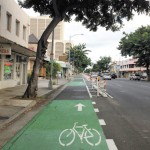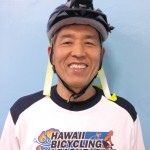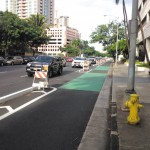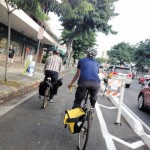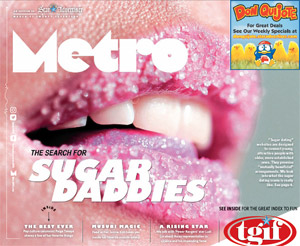Earth/Sky/Mauka/Makai
KING STREET CYCLE TRACK OPENS SATURDAY
Honolulu recently was recognized as a bike-friendly city — and one of the reasons is King Street Cycle Track, which opens for use Dec. 6. Cycle tracks are protected bike lanes that are offset from traffic with a curbed barrier — rather than just a painted line. King Street Cycle Track is located on the left side of South King Street, occupying one lane and running for about 2 miles from Alapai Street to Isenberg Street. It will run oneway toward University Avenue, with a return lane expected to be operational by mid-2015.
Honolulu earned a bronze-level Bicycle Friendly Community recognition from League of American Bicyclists (LAB) based on the city’s performance in five areas: engineering (infrastructure), education, encouragement, enforcement, and evaluation and planning.
“Honolulu still has a long way to go to become bike friendly,” explains Hawaii Bicycling League (HBL) executive director Chad Taniguchi, adding that this protected bike lane marks a huge stride in safety.
- HBL executive director Chad Taniguchi
- King Street Cycle Track is set off from the main street by curbs; areas where the barriers end are marked in green
- The King Street Cycle Track opens Dec. 6 PHOTOS COURTESY HAWAII BICYCLING LEAGUE
The cycle track launches with a grand opening celebration from 11 a.m. to 3 p.m. at Thomas Square Park, featuring live entertainment, a keiki bike rodeo for kids ages 4-16, food trucks, free bike repairs and more. At 1 p.m., Mayor Kirk Caldwell will lead an inaugural ride down the track.
Legislation, including the Complete Streets ordinance and the Vulnerable Users Law, which were adopted in 2012, also helped Honolulu earn the recognition. Complete Streets pushed the city to create streets that take the needs of all road users into consideration, while the Vulnerable Users Law increased penalties on motorists who kill or injury pedestrians, bicyclists and emergency responders. Other significant bike-friendly strides in recent years include the addition of bike lanes on Waialae and Kalakaua avenues. A bike lane currently is under construction on Beretania Street.
In addition to advocating for legislative changes, HBL also has played a role in increasing bike friendliness through education and encouragement, hosting weekly rides and instructional classes. Various weekly rides cater to all skill levels, from beginners to racing-level cyclists.
Despite the LAB accolade, Taniguchi says he encounters many people who are hesitant to bicycle in downtown Honolulu because of safety concerns. Taniguchi feels, however, that perception is larger than the actual threat.
Taniguchi has been biking around Honolulu for the last 11 years — a hobby he returned to during the 2003 bus strike, after not biking for more than 20 years.
“I caught rides during the strike, and I started to think, ‘How else could I get around?'” he explains.
When the strike was over, he kept at it, commuting between his Kailua home and Kalihi office by using both modes of transportation.
“It saved me time, actually, because I didn’t have to transfer (buses),” he says.
According to Taniguchi, the new protected lane will make traveling down King Street safer for pedestrians. Currently, he says, many cyclists riding down King Street use the sidewalk, where they may collide with pedestrians.
“It’s not just good for cyclists,” Taniguchi says, “it’s good for everyone who uses the road.”
HBL hopes that this cycle track is just the first of many; Taniguchi wants to see a network of the lanes installed throughout the city.
“Having one on King Street is great — but when (cyclists) get to the end of King Street, where are they going to go?” he says. “There should be enough (cycle tracks) where we can get from Hawaii Kai to Kalihi in a safe way.”
For more information on bike safety, classes and weekly rides, visit hbl.org.

